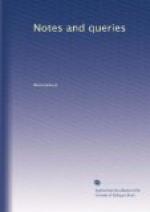T. SIMPSON EVANS.
Shoreditch.
Probabilism.—Will any one inform me by whom the doctrine of Probabilism was first propounded as a system? And whether, when fairly stated, it is any thing more than the enunciation of a deep moral principle?
R.P.
Sir Henry Chauncy’s Observations on Wilfred Entwysel.—After recording the inscription on the brass plate in St. Peter’s Church, St. Alban’s, to the memory of Sir Bertin Entwysel, Knt., Viscount and Baron of Brykbeke in Normandy, who fell at the first battle of St. Alban’s, in 1455, Chauncy proceeds to state:—
“These Entwysels were gentlemen of good account in Lancashire, whose mansion-house retains the name of Entwysel, and the last heir of that house was one Wilfred Entwysel, who sold his estate, and served as a lance at Musselborrow Field, Anno 2 Edw. VI. After that he served the Guyes in defence of Meth, and he was one of the four captains of the fort of Newhaven, who being infected with the plague and shipped for England, landed at Portsmouth, and uncertain of any house, in September, 1549, died under a hedge.”—Historical Antiq. of Hertfordshire, by Sir Henry Chauncy, Knt., Serj. at Law, p. 472. fol. 1700.
On what authority is this latter statement made, and if it was traditional when Chauncy wrote, was the foundation of the tradition good? Did Sir Bertin Entwysel leave issue male, and is the precise link ascertained which connects him with the family of Entwisle of Entwisle, in the parish of Bolton-en-le-Moors, in Lancashire? Wilfred Entwysel was not “the last heir of that house,” as the post mortem inq. of Edmund Entwisle, of Entwisle, Esq., was taken 14 Sept. 1544, and his son and heir was George Entwisle, then aged twenty-two years and upwards. Amongst his large estates was “the manor of Entwissell.”
F.R.R.
Theological Tracts.—Can any of your correspondents inform me where the following tracts are to be found?—
“Pattern of the Present Temple,” “Garnish of the Soul,” “Soldier of Battle,” “Hunt of the Fox,” “Fardle of Fashions,” “Gamer’s Arraign,” and a work entitled “Vaux’s Catechism.”
I am sorry not to be able to give a more minute description of them; they were all published, I think, before the middle of the seventeenth century.
The Bodleian and our own University Libraries have been searched, but to no purpose.
S.G.
Lady Bingham.—In Blackwood’s Magazine, vol. lxviii. p. 141. there is a paper, bearing every mark of authenticity, which details the unsuccessful courtship of Sir Symonds D’Ewes with Jemima, afterwards Baroness Crewe, and daughter of Edward Waldgrave, Esq., of Lawford House in Essex, and Sarah his wife. It is stated that the latter bore the name of Lady Bingham, as being the widow of a knight, and that his monument may still be seen




